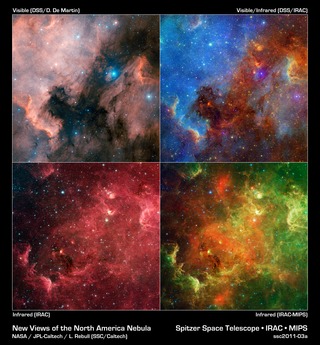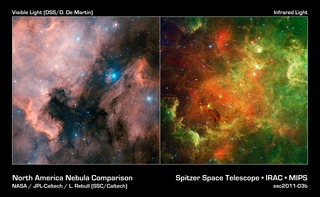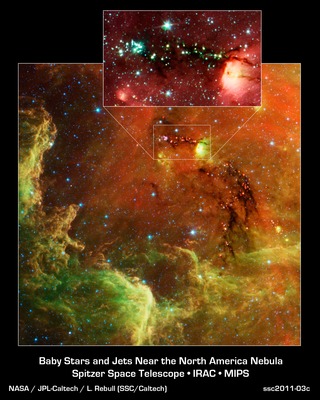
Credit: NASA/JPL-Caltech/L. Rebull (SSC/Caltech)
Observation • February 10th, 2011 • ssc2011-03a
ssc2011-03a
This image layout reveals how the appearance of the North America nebula can change dramatically using different combinations of visible and infrared observations from the Digitized Sky Survey and NASA's Spitzer Space Telescope, respectively.
In this progression, the visible-light view (upper left) shows a striking similarity to the North America continent. The image highlights the eastern seaboard and Gulf of Mexico regions. The red region to the right is known as the "Pelican nebula," after its resemblance in visible light to a pelican.
The view at upper right includes both visible and infrared observations. The hot gas comprising the North America continent and the Pelican now takes on a vivid blue hue, while red colors display the infrared light. Inky black dust features start to glow in the infrared view.
In the bottom two images, only infrared light from Spitzer is shown -- data from the infrared array camera is on the left, and data from both the infrared array camera and the multiband imaging photometer, which sees longer wavelengths, is on the right. These pictures look different in part because infrared light can penetrate dust whereas visible light cannot. Dusty, dark clouds in the visible image become transparent in Spitzer's view. In addition, Spitzer's infrared detectors pick up the glow of dusty cocoons enveloping baby stars.
Color is used to display different parts of the spectrum in each of these images. In the visible-light view (upper right) from the Digitized Sky Survey, colors are shown in their natural blue and red hues. The combined visible/infrared image (upper left) shows visible light as blue, and infrared light as green and red. The infrared array camera (lower left) represents light with a wavelength of 3.6 microns as blue, 4.5 microns as green, 5.8 microns as orange, and 8.0 microns as red. In the final image, incorporating the multiband imaging photometer data, light with a wavelength of 3.6 microns has been color coded blue; 4.5-micron light is blue-green; 5.8-micron and 8.0-micron light are green; and 24-micron light is red.
About the Object
- Name
- North America Nebula • NGC 7000 • Pelican Nebula • IC 5070 • IC 5067
- Type
- Nebula > Type > Star Formation
- Nebula > Appearance > Emission
- Nebula > Appearance > Dark
- Star > Evolutionary Stage > Protostar
- Distance
- 2,000 Light Years
Color Mapping
| Band | Wavelength | Telescope |
| Infrared | 3.6 µm | Spitzer IRAC |
| Infrared | 4.5 µm | Spitzer IRAC |
| Infrared | 5.8 µm | Spitzer IRAC |
| Infrared | 8.0 µm | Spitzer IRAC |
| Infrared | 24.0 µm | Spitzer MIPS |
Astrometrics
- Position (J2000)
- RA =20h 55m 33.8s
- Dec = 44° 7' 50.9"
- Field of View
- 2.3 x 2.3 degrees
- Orientation
- North is 356.4° left of vertical











